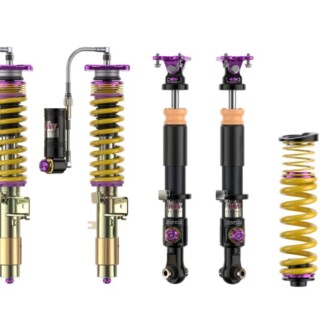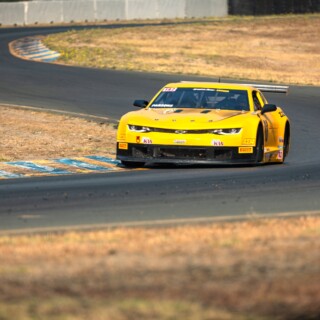
A few months ago, the Tesla Model 3 driver, Arnold Kleitsch from the e-mobility blog Smaveo.de, conducted an interview with us about KW coilovers for the Tesla Model 3. We are pleased to publish excerpts of this talk on our KW automotive blog. We extend a huge thank you to Mr. Kleitsch for the opportunity.

How can you describe the typical Tesla Model 3 driver who purchases a KW coilover?
Many Model 3 drivers are “early adopters” and after the initial euphoria of their Tesla’s handling on back roads and speedy highway drives, they seem to become a bit disillusioned and are looking for room for improvement.

Since the release of the Tesla Model 3, many new customers have contacted us about the KW Variant 3 and how surprised they were with the part. They feel like they are now driving a completely different car. Some of our Model 3 customers have already driven vehicles with KW suspensions in the past and made good experiences with them.

Are there customers who buy the suspension specifically because of the increase in efficiency and not really because of its sporty character?
Partly yes. Nextmove, for example, discovered that the range is increased by the KW Variant 3 and that you can also compensate for wider tires, since this results in an increase in consumption.
However, most people deliberately purchase the KW Variant 3 for their Tesla because they are looking for better driving performance combined with stepless lowering (coilover). The tested adjustment range for a stepless lowering on the front axle is 25 to 55 millimeters. A stepless lowering of 25 to 50 millimeters can be set on the drive axle of the Tesla Model 3 with rear-wheel drive. For the AWD Variants, 25 to 50 millimeters are possible on both axles.

Why should an end customer consider buying a KW suspension for his Tesla Model 3?
Someone who consciously decides for the KW Variant 3 coilover in the Model 3 or another vehicle attaches more importance to driving a car than just getting from point A to point B. The fact that you can also lower your car, thanks to KW Variant 3, is no longer the most decisive aspect, but it is an additional benefit to the driving dynamics. Rather, a KW Variant 3 ensures a much more dynamic and safer ride without having to sacrifice sporty ride comfort.
To what extent does the demand for a coilover for the Tesla Model 3 meet your expectations?
We were totally surprised by the high demand for of coilovers for the Model 3. A completely new target group that never actually considered buying a coilover before was created. We heard from several dealers that some Model 3 drivers are also upgrading their other vehicles to a KW coilover.

Are there any differences (in terms of demand) between the all-wheel drive models and the rear-wheel drive vehicles?
This depends on the market. In Europe, the demand for our KW Variant 3 for all-wheel-drive models is predominant. Thus, KW also benefits from the fact that we do not hesitate to develop all-wheel-drive suspensions and, for instance, also manufacture suspension struts for complex front-axle designs for all-wheel-drive vehicles from BMW, Mercedes-Benz, and also for Tesla.

As you may know, the Model 3 has quite a high torque which is available directly to the point. Does this also have an effect on the chassis?
Of course. For example, a difference between our suspensions and others in the market is that we always offer vehicle-specific developments. The entire damper setup of the KW Variant 3 for the Tesla Model 3 is designed for its performance, vehicle weight and impressive torque. Granted, that’s how we construct every vehicle.
More than 26,000 different suspension applications have been part of our portfolio for over 2,350 vehicles. We’ve developed more than 16 distinct damper technologies in recent years so that we can offer all our customers the perfect suspension for every demand. With the support of the German government, we are currently working together with DLR (“Deutsches Zentrum für Luft- und Raumfahrt e. V.” German Aerospace Center) on a new suspension technology in which the chassis control is supported by artificial intelligence.

How does the replacement of a suspension or coilover affect the manufacturer’s warranty?
We are not aware of any case at KW automotive in which the manufacturer’s warranty was invalidated as a result of the professional installation of the suspension according to the parts certificate and the manufacturer’s specifications.
Whom should I contact if I would like to buy a KW Variant 3 for my Tesla Model 3?

It is best to contact our certified KW dealers, who also carry out wheel alignment besides the installation. To make it easier, we implemented a dealer search on our KW homepage.
How much is the installation of a KW Variant 3 suspension and what needs to be done?

We can’t say much about the installation costs since it varies from region to region and depends on the respective brand and model. Good craftsmanship and work have their price. In any case, depending on the age of the vehicle, typical wear parts such as series top mounts, tie rod ends, coupling rods, etc. should be replaced when changing the suspension, and a wheel alignment should be carried out immediately after installing the chassis.

Another hint: when the suspension is installed, you should not use an impact wrench directly on the suspension or install the struts and dampers with a braced wheel suspension (control arm, …). Plus, a KW coilover cannot settle when properly installed thanks to its high-strength suspension spring alloy.
Has the Model 3 already proven itself in conjunction with the KW suspension on the racetrack?
Of course, but a KW Variant 3 coilover is deliberately designed in its entire layout and concept, not as performant such as our KW Clubsport or KW racing suspensions – the famous KW Competition product range. A suspension that is perfect for the Hockenheim Ring is simply not satisfactory on the country road or in everyday life.

Here’s what is always so amazing about vehicle tests: car X is compared with car Z based on the lap time on racetrack XY. There is barely a driver who takes his everyday car to a racetrack, and only very few come close to the lap time of a test driver or even a professional race driver.

How do the driving performances of a coilover and the one of a spring lowering differ?
That’s simple driving physics. With a lowering spring kit, the spring manufacturers must use higher or stiffer spring rates. This means that the lower spring travel makes the handling unnecessarily stiffer in everyday use. There is also an increased risk that the standard damper will wear out more quickly, because the working range is no longer optimal. When switching to a coilover from high-quality manufacturers, the respective suspension components – valve springs, piston rod, suspension springs – are perfectly matched to the respective vehicle axle load and axle kinematics.

The times in which a coilover makes the handling unnecessarily uncomfortable are long gone. For instance, with our KW coilovers, we even enable an increased suspension travel compared to the standard versions, despite lowering the car. Therefore, our suspension can control the vibrations caused by driving on different surfaces much better.
You can also read the entire German conversation directly at www.smaveo.de or watch the German Smaveo Video.










